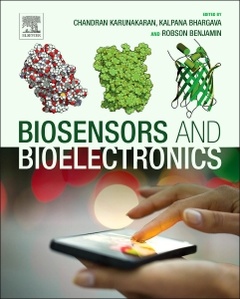Biosensors and Bioelectronics
Auteurs : Karunakaran Chandran, Bhargava Kalpana, Benjamin Robson

Biosensors and Bioelectronics presents the rapidly evolving methodologies that are relevant to biosensors and bioelectronics fabrication and characterization. The book provides a comprehensive understanding of biosensor functionality, and is an interdisciplinary reference that includes a range of interwoven contributing subjects, including electrochemistry, nanoparticles, and conducting polymers.
Authored by a team of bioinstrumentation experts, this book serves as a blueprint for performing advanced fabrication and characterization of sensor systems?arming readers with an application-based reference that enriches the implementation of the most advanced technologies in the field.
1. Introduction to biosensors;
2. Enzymatic and Enzyme Mimetic Biosensors;
3. Nanomaterial Enhanced Electrochemical Biosensors;
4. Immunosensors;
5. Bioelectronics.
Chemical Engineers (primarily those in the R&D sector), Electronics Engineers, and Materials Scientists. Secondary audience includes students at the upper undergraduate and graduate level taking related coursework
- Features descriptions of functionalized nanocomposite materials and carbon fibre electrode-based biosensors for field and in vivo applications
- Presents a range of interwoven contributing subjects, including electrochemistry, nanoparticles, and conducting polymers
- Includes more than 70 figures and illustrations that enhance key concepts and aid in retention
- Ideal reference for those studying bioreceptors, transducers, bioinstrumentation, nanomaterials, immunosensors, nanotubes, nanoparticles, and electrostatic interactions
- Authored by a collaborative team of scientists with more than 50 years of experienced in field research and instruction combined
Date de parution : 07-2015
Ouvrage de 344 p.
19x23.3 cm
Thèmes de Biosensors and Bioelectronics :
Mots-clés :
Antibodies; antigen; Apoptosis; Bienzymatic; biofunctionalization; Biomarkers; Biosensors; cancer cells; Cholesterol; Cytochrome c; Electrochemical analyzer; Electrochemical immunosensors; ELISA; Enzymatic biosensors; field effect transistor; genosensor; Glucose; immobilization strategies; Immunoassay; immunosensor; Key words; LabVIEW; Metalloporphyrin; metalloproteins; Microcontroller; Mimetic; molecular recognition; nanocomposite matrix; Nanoparticles; Organic conducting polymers; Oxidative stress; Potentiostat; transducers; Transimpedance amplifier; USB; Virtual instrumentation


